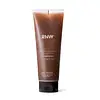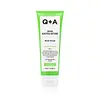What's inside
What's inside
 Key Ingredients
Key Ingredients

 Benefits
Benefits

 Concerns
Concerns

 Ingredients Side-by-side
Ingredients Side-by-side

Water
Skin ConditioningAmmonium Lauryl Sulfate
CleansingJuglans Regia Shell Powder
AbrasiveAcrylates Copolymer
Microcrystalline Cellulose
AbsorbentCellulose
AbsorbentButylene Glycol
HumectantTromethamine
BufferingSodium Benzoate
MaskingCitric Acid
BufferingGlycerin
HumectantParfum
MaskingSodium Chloride
MaskingBetula Platyphylla Japonica Juice
Skin ConditioningPanthenol
Skin ConditioningBlack Strap Powder
HumectantLimonene
PerfumingLinalool
PerfumingPolyquaternium-7
Camellia Sinensis Leaf Extract
AntimicrobialDisodium EDTA
Glycyrrhiza Glabra Root Extract
BleachingAgrimonia Eupatoria Extract
AstringentDextrin
AbsorbentTheobroma Cacao Extract
Skin ConditioningHydrogenated Lecithin
EmulsifyingPerilla Frutescens Leaf Extract
MaskingSaponaria Officinalis Extract
Skin ConditioningFicus Carica Fruit Extract
HumectantCentella Asiatica Extract
CleansingKigelia Africana Fruit Extract
Skin Conditioning1,2-Hexanediol
Skin ConditioningCeramide NP
Skin ConditioningCoffea Arabica Seed Powder
AbrasiveCocos Nucifera Oil
MaskingElaeis Guineensis Kernel Oil
EmollientYeast Extract
Skin ConditioningPhaseolus Radiatus Seed Extract
Skin ConditioningPolygonum Fagopyrum Seed Extract
Skin ConditioningHordeum Distichon Extract
Skin ProtectingOryza Sativa Extract
AbsorbentCoix Lacryma-Jobi Ma-Yuen Seed Extract
Skin ConditioningSesamum Indicum Seed Extract
Skin ConditioningGlycine Soja Seed Extract
Skin ConditioningRosa Damascena Flower Oil
MaskingWater, Ammonium Lauryl Sulfate, Juglans Regia Shell Powder, Acrylates Copolymer, Microcrystalline Cellulose, Cellulose, Butylene Glycol, Tromethamine, Sodium Benzoate, Citric Acid, Glycerin, Parfum, Sodium Chloride, Betula Platyphylla Japonica Juice, Panthenol, Black Strap Powder, Limonene, Linalool, Polyquaternium-7, Camellia Sinensis Leaf Extract, Disodium EDTA, Glycyrrhiza Glabra Root Extract, Agrimonia Eupatoria Extract, Dextrin, Theobroma Cacao Extract, Hydrogenated Lecithin, Perilla Frutescens Leaf Extract, Saponaria Officinalis Extract, Ficus Carica Fruit Extract, Centella Asiatica Extract, Kigelia Africana Fruit Extract, 1,2-Hexanediol, Ceramide NP, Coffea Arabica Seed Powder, Cocos Nucifera Oil, Elaeis Guineensis Kernel Oil, Yeast Extract, Phaseolus Radiatus Seed Extract, Polygonum Fagopyrum Seed Extract, Hordeum Distichon Extract, Oryza Sativa Extract, Coix Lacryma-Jobi Ma-Yuen Seed Extract, Sesamum Indicum Seed Extract, Glycine Soja Seed Extract, Rosa Damascena Flower Oil
Water
Skin ConditioningZea Mays Cob Powder
AbrasiveGlycerin
HumectantCetearyl Alcohol
EmollientLactic Acid
BufferingGlyceryl Stearate
EmollientHelianthus Annuus Seed Oil
EmollientCaprylic/Capric Triglyceride
MaskingGlycolic Acid
BufferingHippophae Rhamnoides Fruit Oil
Skin ProtectingSimmondsia Chinensis Seed Oil
EmollientVitis Vinifera Seed Oil
EmollientCarbomer
Emulsion StabilisingSodium Stearoyl Glutamate
CleansingCoco-Glucoside
CleansingSodium Gluconate
Skin ConditioningPotassium Sorbate
PreservativeSodium Benzoate
MaskingParfum
MaskingCoconut Alcohol
EmollientSodium Hydroxide
BufferingBenzyl Cinnamate
PerfumingCoumarin
PerfumingWater, Zea Mays Cob Powder, Glycerin, Cetearyl Alcohol, Lactic Acid, Glyceryl Stearate, Helianthus Annuus Seed Oil, Caprylic/Capric Triglyceride, Glycolic Acid, Hippophae Rhamnoides Fruit Oil, Simmondsia Chinensis Seed Oil, Vitis Vinifera Seed Oil, Carbomer, Sodium Stearoyl Glutamate, Coco-Glucoside, Sodium Gluconate, Potassium Sorbate, Sodium Benzoate, Parfum, Coconut Alcohol, Sodium Hydroxide, Benzyl Cinnamate, Coumarin
Ingredients Explained
These ingredients are found in both products.
Ingredients higher up in an ingredient list are typically present in a larger amount.
Glycerin is already naturally found in your skin. It helps moisturize and protect your skin.
A study from 2016 found glycerin to be more effective as a humectant than AHAs and hyaluronic acid.
As a humectant, it helps the skin stay hydrated by pulling moisture to your skin. The low molecular weight of glycerin allows it to pull moisture into the deeper layers of your skin.
Hydrated skin improves your skin barrier; Your skin barrier helps protect against irritants and bacteria.
Glycerin has also been found to have antimicrobial and antiviral properties. Due to these properties, glycerin is often used in wound and burn treatments.
In cosmetics, glycerin is usually derived from plants such as soybean or palm. However, it can also be sourced from animals, such as tallow or animal fat.
This ingredient is organic, colorless, odorless, and non-toxic.
Glycerin is the name for this ingredient in American English. British English uses Glycerol/Glycerine.
Learn more about GlycerinParfum is a catch-all term for an ingredient or more that is used to give a scent to products.
Also called "fragrance", this ingredient can be a blend of hundreds of chemicals or plant oils. This means every product with "fragrance" or "parfum" in the ingredients list is a different mixture.
For instance, Habanolide is a proprietary trade name for a specific aroma chemical. When used as a fragrance ingredient in cosmetics, most aroma chemicals fall under the broad labeling category of “FRAGRANCE” or “PARFUM” according to EU and US regulations.
The term 'parfum' or 'fragrance' is not regulated in many countries. In many cases, it is up to the brand to define this term.
For instance, many brands choose to label themselves as "fragrance-free" because they are not using synthetic fragrances. However, their products may still contain ingredients such as essential oils that are considered a fragrance by INCI standards.
One example is Calendula flower extract. Calendula is an essential oil that still imparts a scent or 'fragrance'.
Depending on the blend, the ingredients in the mixture can cause allergies and sensitivities on the skin. Some ingredients that are known EU allergens include linalool and citronellol.
Parfum can also be used to mask or cover an unpleasant scent.
The bottom line is: not all fragrances/parfum/ingredients are created equally. If you are worried about fragrances, we recommend taking a closer look at an ingredient. And of course, we always recommend speaking with a professional.
Learn more about ParfumSodium Benzoate is a preservative. It's used in both cosmetic and food products to inhibit the growth of mold and bacteria. It is typically produced synthetically.
Both the US FDA and EU Health Committee have approved the use of sodium benzoate. In the US, levels of 0.1% (of the total product) are allowed.
Sodium benzoate works as a preservative by inhibiting the growth of bacteria inside of cells. It prevents the cell from fermenting a type of sugar using an enzyme called phosphofructokinase.
It is the salt of benzoic acid. Foods containing sodium benzoate include soda, salad dressings, condiments, fruit juices, wines, and snack foods.
Studies for using ascorbic acid and sodium benzoate in cosmetics are lacking, especially in skincare routines with multiple steps.
We always recommend speaking with a professional, such as a dermatologist, if you have any concerns.
Learn more about Sodium BenzoateWater. It's the most common cosmetic ingredient of all. You'll usually see it at the top of ingredient lists, meaning that it makes up the largest part of the product.
So why is it so popular? Water most often acts as a solvent - this means that it helps dissolve other ingredients into the formulation.
You'll also recognize water as that liquid we all need to stay alive. If you see this, drink a glass of water. Stay hydrated!
Learn more about Water